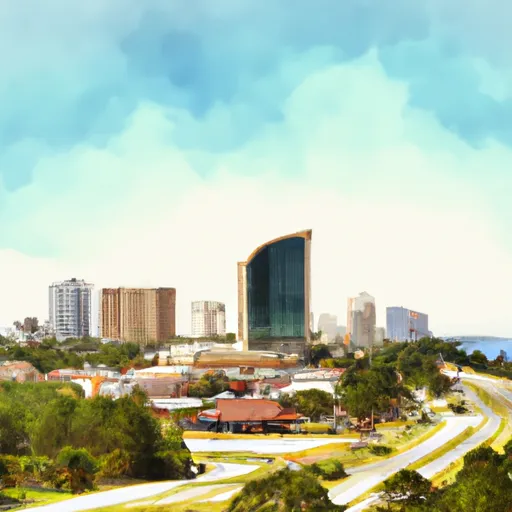-
 Snoflo Premium
Snoflo Premium
Get unlimited access to all our content
With no Ad interruptions! - Start Your Free Trial Login with existing account
San-Mateo
Eden Index
Climate
7.3
•
Recreation
6.0
•
Community
0.7
•
Safeguard
5.2/10

San Mateo, Florida is a charming town located in Putnam County, nestled along the eastern coast of the state. The climate in this area is classified as humid subtropical, with hot and humid summers and mild winters. The average temperature ranges from the mid-80s Fahrenheit in summer to the low 60s in winter, making it an ideal destination for those seeking warmer climates.
San Mateo benefits from its proximity to the St. Johns River, which flows through the town. The river's hydrology constituents contribute to a diverse ecosystem, supporting various plants and wildlife. Fishing enthusiasts can enjoy casting their lines for bass, catfish, and other freshwater species.
Outdoor recreation opportunities abound in San Mateo. The nearby St. Johns River offers boating, kayaking, and canoeing opportunities, allowing visitors to explore the scenic waterways. Additionally, the area is home to several state parks, such as Dunns Creek State Park and Rice Creek Conservation Area, where visitors can hike, bike, and observe the local flora and fauna.
In conclusion, San Mateo, Florida offers a pleasant climate, beautiful hydrology constituents, and an array of outdoor activities, making it an appealing destination for nature lovers and outdoor enthusiasts.
What is the Eden Index?
The Snoflo Eden Index serves as a comprehensive rating system for regions, evaluating their desirability through a holistic assessment of climate health, outdoor recreation opportunities, and natural disaster risk, acknowledging the profound impact of these factors on livability and well-being.
Climate Health Indicator (CHI): 7.3
San-Mateo receives approximately
1320mm of rain per year,
with humidity levels near 89%
and air temperatures averaging around
21°C.
San-Mateo has a plant hardyness factor of
9, meaning
plants and agriculture in this region tend to thrive here all year round.
By considering the ideal temperature range, reliable water supplies, clean air, and stable seasonal rain or snowpacks, the Climate Health Indicator (CHI) underscores the significance of a healthy climate as the foundation for quality living.
A healthy climate is paramount for ensuring a high quality of life and livability in a region, fostering both physical well-being and environmental harmony. This can be characterized by ideal temperatures, reliable access to water supplies, clean air, and consistent seasonal rain or snowpacks.
Weather Forecast
Streamflow Conditions
St. Johns
Area Rivers
St. Johns
Snowpack Depths
St. Johns
Reservoir Storage Capacity
St. Johns
Groundwater Levels
Recreational Opportunity Index (ROI): 6.0
The Recreational Opportunity Index (ROI) recognizes the value of outdoor recreational options, such as parks, hiking trails, camping sites, and fishing spots, while acknowledging that climate plays a pivotal role in ensuring the comfort and consistency of these experiences.
Access to outdoor recreational opportunities, encompassing activities such as parks, hiking, camping, and fishing, is crucial for overall well-being, and the climate plays a pivotal role in enabling and enhancing these experiences, ensuring that individuals can engage in nature-based activities comfortably and consistently.
Camping Areas
| Campground | Campsites | Reservations | Toilets | Showers | Elevation |
|---|---|---|---|---|---|
| Magnolia County Park | 96 | 81 ft | |||
| Clearwater Lake | 62 | 81 ft | |||
| Turkey Lake City Park | None | 122 ft | |||
| Hontoon Island State Park | None | 0 ft | |||
| Big Bass | 34 | 69 ft | |||
| Wekiwa Springs State Park | None | 78 ft | |||
| Trimble County Park | 15 | 65 ft | |||
| Clarcona Horse Park | None | 85 ft | |||
| Lake Louisa State Park | None | 154 ft | |||
| Kelly | None | 71 ft |
Catastrophe Safeguard Index (CSI):
The Catastrophe Safeguard Index (CSI) recognizes that natural disaster risk, encompassing floods, fires, hurricanes, and tornadoes, can drastically affect safety and the overall appeal of an area.
The level of natural disaster risk in a region significantly affects safety and the overall livability, with climate change amplifying these risks by potentially increasing the frequency and intensity of events like floods, fires, hurricanes, and tornadoes, thereby posing substantial challenges to community resilience and well-being.
Community Resilience Indicator (CRI): 0.7
The Community Resilience Indicator (CRI) recognizes that education, healthcare, and socioeconomics are crucial to the well-being of a region. The CRI acknowledges the profound impact of these elements on residents' overall quality of life. By evaluating educational resources, healthcare accessibility, and economic inclusivity, the index captures the essential aspects that contribute to a thriving community, fostering resident satisfaction, equity, and social cohesion.

